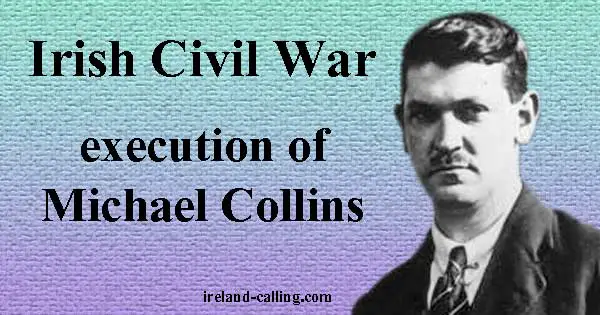A new theory has been put forward by an Irish historian which casts doubt over whether the man believed to have killed Michael Collins could have been the one responsible.
Irish leader Collins was killed by a sniper in his home county Cork in an ambush at Béal na Bláth on August 22, 1922.
It was the most significant event in the Irish Civil War which followed Collins’ signing of the Anglo-Irish Treaty.
There has always been a general belief that former British soldier Denis ‘Sonny’ O’Neill had been the one who fired the shot which killed Collins.
There was no autopsy on the body to offer any clues as to the killer. Former IRA intelligence officer Eamonn de Barra once alluded that O’Neill was the man who killed Collins, and he is confirmed to have present at the ambush by files in the Military Service Pensions Collection.
However, historian Paddy Cullivan believes there is evidence that suggests O’Neill could not have been the killer.
He pointed out that O’Neill had never served as a sniper during his career in the British Army. If he was trained in this skill, then the IRA, who he joined after the First World War, would have used him as a sniper during the War of Independence, which they didn’t.
There is also evidence in German historical archives that he that suffered an injury to his right arm while being held as a prisoner of war in 1918.
The British records state that O’Neill had a 40% disability in his right arm. Realistically, that would have made it almost impossible to accurately aim and fire a sniper rifle.
Cullivan believes this evidence should rule out O’Neill as the guilty marksman, although he does concede that the true details of what happened remain uncertain.
The signing of the Anglo-Irish Treaty that ended the War of Independence split the Irish Republican Army in two, with half believing it offered the platform for an independent Ireland, and half believing too many concessions had been made to the British.
What followed was the Irish Civil War, which saw family members and former comrades fighting on opposite sides as the new Free State government tried to take control of Ireland quell the rebellion of the Anti-Treaty IRA.
Collins knew that by signing the Treaty he had put a target on his back, but felt he had no choice. He mentioned in a letter to his sweetheart Kitty Kiernan that he had ‘signed my own death warrant’.
Cullivan added that a possible culprit for the murder could even be Major General Emmet Dalton. He travelled in the same touring car as Collins and his testimony of the incident was littered with inconsistencies.
With pro and anti-Treaty factions of the IRA going to war with each other, it is not unthinkable that an experienced soldier such as Dalton may have acted as a double agent in order to gain access to one of the key leaders of his enemy.
Cullivan was keen to point out that he is not accusing Dalton of the murder, but would consider him as the prime suspect if the shot was fired by a member of the pro-Treaty side.
The real life mystery of what Maureen O’Hara whispered to make John Wayne look so shocked
Action hero Tom Cruise was once attacked by an old man in a Kerry pub
Billy Connolly says public should ignore politicians and listen to comedians
